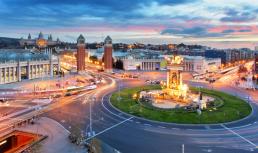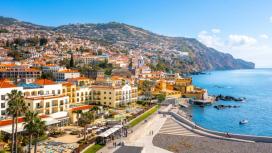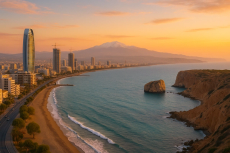Blog • Published on:February 13, 2025 | Updated on:February 13, 2025 • 29 Min
Living in Spain: A Guide to Spanish Residency
Moving to Spain as an expat is an exciting adventure, filled with European charm, a laid-back lifestyle, and surprisingly affordable living compared to many other countries. It doesn’t take long to feel right at home, as Spanish people are typically very welcoming, polite, and hospitable.
But, before you decide to move, it's essential to grasp the practical aspects of relocating. From the legalities of residency and healthcare to finding the perfect place to live and adapting to local customs, a little preparation goes a long way in making your move smoother and your new life more enjoyable.
In this article, we’ll walk you through everything you need to know about moving to Spain, from securing long-term residency to navigating the cost of living, and a whole lot more.
Spanish Residency Option Overview
Until January 2025, the Spanish Golden Visa Program was the most popular long-term residency route for moving to Spain. This visa allowed people to make a real estate investment in the country and then renew their residency.
However, because of housing shortages and other concerns, the government decided to permanently close the program. Existing applicants can still qualify for the visa until April 2025, so we won’t be focusing on it here. Instead, we’ll concentrate on the current options available.
If you want to learn more about the closure of the Golden Visa Program and the reasons behind the government’s decision, you can check out this information: Spain Ends Golden Visa Program as Congress Overrides Senate Veto
And here are the main existing long-term visa options for smooth relocation:
Spain Non-Lucrative Visa
This route is especially popular with individuals who have independent financial means and do not need to engage in local employment. It is ideal for retirees, people with foreign-based passive income, or those who simply want a change in environment.
- Key Financial Requirements: Applicants must show that they can cover living costs in Spain without working locally. Documentation often includes bank statements or proof of pension.
- Restrictions: Visa holders should not engage in direct work for a Spanish employer. Remote or online work for foreign clients may be acceptable if local regulations are respected.
- Initial Duration: Typically, valid for one year. Renewals may extend the permit if the individual continues to meet eligibility criteria.
Many find the Non-Lucrative Visa appealing because it offers the freedom to enjoy Spanish culture and lifestyle without the obligations of local employment. However, it is vital to maintain evidence of sufficient finances to meet the consulate or immigration office’s criteria at each renewal stage.
Spain Digital Nomad Visa
Remote work has become a popular trend in recent years, and Spain has adapted to this shift by introducing a specific pathway for those who can perform their jobs online. The Digital Nomad Visa is the best for freelancers, remote employees of foreign companies, and entrepreneurs managing location-independent businesses.
- Eligibility Requirements: Candidates should have verifiable income streams tied to activities outside Spain. This typically means contracts with foreign employers, clients, or an overseas-based business.
- Required Documents: Alongside the usual residency paperwork, applicants need letters from their employers or clients confirming their remote arrangement. Proof of a stable monthly income is also common.
- Benefit: Holders can enjoy the Spanish climate and culture while working at a distance. It is a fitting option for professionals who want to expand their horizons without disconnecting from ongoing projects or assignments.
Because digital work is flexible, many people find Spain’s cultural richness, well-established public services, and overall lower cost of living (compared to some other European nations) to be significant draws.
Spain Student Visa
Aspiring scholars looking to attend universities or recognized institutions can apply for a Student Visa. This category accommodates degree programs, language schools, and specialized training courses.
- Main Requirements: An acceptance letter from a Spanish institution, proof of financial capacity to cover tuition and living expenses, and valid health insurance.
- Duration: Generally, covers the length of the study program, although shorter or longer courses may modify validity.
- Potential to Extend: If studies continue, students can usually renew their visas by presenting updated documents and proof of ongoing enrollment.
Some individuals begin with a Student Visa and later transition to other visas or permits, depending on new career opportunities or personal goals.
Financial Requirements for Spanish Visas
Spain’s visa categories each have specific financial criteria that applicants must meet. These requirements help ensure that newcomers can comfortably cover their expenses during their stay.
Below is a closer look at the main residency pathways, Non-Lucrative Visa, Digital Nomad Visa, and Student Visa, along with details on minimum income levels and suitable evidence of funds.
Non-Lucrative Visa
Minimum Income and Savings
The Non-Lucrative Visa generally requires that applicants have sufficient funds to cover living expenses without undertaking paid employment in Spain. Officials use the IPREM as a reference point for measuring financial capacity. For the year 2025:
- Main Applicant: A monthly income of at least €2,400 (which equals 400% of the IPREM), adding up to €28,800 per year.
- Additional Family Members: Each dependent pushes the monthly figure higher by €600.
For instance, if one spouse or child joins the main applicant, that increases the requirement from €2,400 to €3,000 per month in total.
Proving Financial Means
Applicants must submit official documentation that shows they have stable and adequate resources. Consulates and immigration offices generally accept:
- Bank Statements: Provide records for at least six months, highlighting a consistent account balance or deposits.
- Savings Accounts: A substantial lump sum can also prove you can cover living costs.
- Investment Income: Rental properties, dividends, bonds, or other investments are acceptable, as long as they offer a reliable revenue stream.
- Pension Documents: Those relying on a pension should submit official statements confirming the regular receipt of payments.
All evidence should be recent, valid, and translated into Spanish if required by the consulate.
For the Non-Lucrative Visa, Spanish authorities want reassurance that newcomers will not need local employment or government financial assistance.
Providing clear, well-organized documentation strengthens your case and can lead to a smoother application process.
Digital Nomad Visa
Minimum Income
Spain’s Digital Nomad Visa is designed for remote professionals, freelancers, and online business owners whose work is primarily based outside Spain. While official figures may shift, a typical monthly requirement hovers around €2,368.
Since the exact thresholds can vary or be recalculated, checking the most recent government announcements or consulting local consulate guidelines is recommended.
Proving Financial Means
Applicants should show they earn a stable income from sources outside Spain. This might involve:
- Employment Contracts or Client Agreements: Signed contracts or letters from clients verifying ongoing remote work.
- Invoices or Transaction Records: If you are a freelancer, consistent invoicing or revenue data can demonstrate financial stability.
- Bank and PayPal Statements: Any channel used to receive payments should display a steady stream of funds that meets or exceeds the required monthly threshold.
Because the Digital Nomad Visa allows working remotely, the key distinction is proving that your income does not rely on the Spanish job market.
Student Visa
Minimum Income for Students
Financial requirements for the Study Visa typically align with at least 100% of the IPREM. However, some consulates may demand higher amounts, especially if a program is long-term or located in an expensive city.
As a baseline, a student might need to show around €600–€700 per month, but this can vary depending on the duration and location of the study program.
Acceptable Financial Documents
- Bank Statements: At least six months of recent records, showing sufficient balances or regular deposits covering your living costs in Spain.
- Scholarship Letters or Grants: Proof of scholarships or grants that cover tuition and living expenses can supplement or replace personal savings.
- Parental or Guardian Support: If family members are sponsoring your studies, they should submit official proof of their finances, along with a statement expressing their commitment to support you.
Students should Demonstrate that they can afford rent, daily expenses, and other student costs.
Additional Points to Note
- Currency Fluctuations: If you hold assets or receive income in another currency, consider how exchange rates can affect the euro-equivalent amount.
- Translation and Legalization: Some Spanish consulates require translations of all documentation into Spanish by an authorized translator, along with apostilles or other certifications.
- Regular Updates: Requirements may be updated yearly in line with changes to the IPREM, so it is important to confirm the latest figures before applying.
Meeting Spain’s financial thresholds is a central part of visa applications. These standards guarantee that residents can support themselves throughout their stay, whether as retirees on the Non-Lucrative Visa, remote workers on the Digital Nomad Visa, or international students.
By compiling the correct evidence and staying informed of current guidelines, applicants can improve their chances of swift approval.
Other Residency Requirements
Acquiring long-term residency typically involves meeting criteria around finances, health coverage, and documentation. The specific demands differ according to the visa category, but certain foundational elements apply to all.
Documentation Needed
- Valid Passport: Make sure your passport is current and has adequate validity beyond your intended stay. It is common for Spanish consulates to request a minimum of six months’ validity from the application date.
- Completed Visa Application: Spanish consulates usually provide official application forms for each visa category. They must be filled out accurately and signed as instructed.
- Proof of Accommodation: Depending on the pathway, you may need a rental contract, deed, or a letter from someone hosting you in Spain. This demonstrates that you have a place to stay.
- Proof of Funds: You might need bank statements, pension letters, or other documents confirming you can support yourself (and any dependents) without relying on public funds.
- Medical Insurance Documentation: Many visa types mandate comprehensive health insurance, sometimes requiring zero co-pay policies for acceptance.
Health Insurance Requirements
Having health insurance that covers your entire stay is a common requirement. Coverage must be valid in Spain, and some consulates insist on local or internationally recognized providers. Certain categories also require that the policy has no waiting periods and no co-pays, ensuring that medical care is accessible upon arrival.
Criminal Record Check
Applicants often submit an official criminal background check from their country of citizenship or any country they have resided in for a certain period. This document typically requires an apostille (for countries in the relevant convention) and sometimes a sworn translation into Spanish. A clean record is a cornerstone of approval for most long-term stays.
Factors to Consider Before Moving to Spain
Spain has long been recognized for its vibrant cities, historic monuments, and sunny coastlines. That is only part of the appeal.
The country draws people of all ages and backgrounds who seek a blend of tradition and modern living, complete with a focus on social connections and leisure.
Cost of Living in Spain
Spain provides a lifestyle that suits a range of budgets, depending on personal choices and location. Major cities such as Madrid and Barcelona generally have higher housing costs and transportation expenses.
Smaller cities and rural communities often come with lower rents and calmer lifestyles. Below is an expanded look at typical cost categories, along with a brief table to guide you in planning your monthly budget.
Approximate Monthly Cost Breakdown
(Values shown in Euros, estimates for a single individual. Figures can vary based on personal habits and exact location.)
Housing
Housing is often the largest monthly expense. Apartments in central Madrid or Barcelona tend to come with higher price tags, especially in well-known neighbourhoods.
Those looking for more spacious properties at a lower cost may opt for areas outside the city centre or smaller urban centres like Zaragoza or Valencia.
Rental contracts typically last one year, though shorter leases can be negotiated. Owners might request a security deposit and proof of income or financial stability.
- City Center Costs: Rent can reach 1,500 EUR or more for a modest one-bedroom. Premium locations climb higher.
- Smaller Cities: Monthly rents range around 600–900 EUR for comfortable apartments, though upscale parts of town can go beyond that.
- Rural Areas: Some rural towns have rental prices around 400–700 EUR. These usually offer larger living spaces but fewer employment opportunities unless remote work is an option.
Groceries and Dining
Food expenses depend on personal preferences. Many residents combine grocery shopping at supermarkets with visits to local produce markets.
- Groceries: Seasonal fruits, vegetables, and fresh fish can be found at moderate prices. Locally sourced produce is often budget-friendly, especially if you visit municipal markets. Items like imported goods, speciality cheeses, or international products can be more expensive.
- Dining Out: Spain is famous for its “menú del día,” a fixed-price lunch that includes multiple courses and a drink. These meals are more common in smaller eateries and can cost around 10–15 EUR. Upscale restaurants charge more, especially in tourist hotspots.
- Eating Habits: Cooking at home substantially reduces costs. Some residents prepare batch meals and store leftovers to save both time and money.
Transport
Spain’s public transportation network is robust in major cities, though it might be more limited in smaller towns. Many city dwellers find cars unnecessary.
- Metro and Buses: Single fares in Madrid or Barcelona are around 1.50–2.00 EUR, with monthly passes costing between 40–60 EUR. Valencia and Málaga have similar systems, often at slightly lower rates.
- Commuter Trains: Commuter trains (Cercanías) link major cities to nearby suburbs and towns. Monthly passes are priced by zone.
- Cars: A personal vehicle is more common in rural or less connected areas. Costs include fuel, insurance, parking fees, and occasional tolls. Fuel prices fluctuate, so it helps to track them regularly.
Utilities
Electricity, water, gas, and internet are needed for daily comfort. Costs can vary based on consumption, region, and whether your building has centralized or individual heating systems.
- Electricity: Monthly bills hover between 50–80 EUR for smaller apartments. Larger households may pay more. Air conditioning or heating usage can significantly affect bills in extreme weather periods.
- Internet and Phone: Many packages start at around 40 EUR per month for a combined deal, offering decent internet speeds and a mobile plan. Checking different providers is a good approach since rates can vary.
Additional Living Costs
- Healthcare: Residents paying into social security typically have access to public healthcare, which covers essential treatments. Private health insurance is still popular among those seeking shorter wait times or who need coverage to meet visa obligations. Premiums vary based on age and coverage details.
- Leisure and Recreation: Spain’s outdoor culture includes trips to beaches, parks, and hiking routes that are often free or low-cost. More urban pursuits like cinema, concerts, or fitness clubs can add to monthly expenses.
- Child-Related Costs: Parents might consider expenses like childcare, school materials, and extracurricular activities. Those looking into private or international schools face tuition fees beyond what is typical in public institutions.
Housing: Rentals and Real Estate Purchase
When relocating to Spain, it's essential to understand the real estate market to make informed decisions about renting or purchasing a property.
Real Estate Overview:
Spain's real estate market offers a variety of options, including modern apartments, traditional villas, and coastal homes. Demand in popular cities like Madrid, Barcelona, Valencia, and Alicante has led to varying price points. Key factors influencing real estate prices include location, property size, and proximity to amenities.
Renting vs. Buying:
- Renting: Renting is common among expatriates seeking flexibility, with lease agreements typically lasting one year. Rental costs vary widely depending on the city. For instance, in central Madrid, the average price per square meter for second-hand homes was €4,511 in December 2024.
- Buying: Purchasing property in Spain is a long-term investment favoured by those committed to residing in the country. Mortgages are available to expatriates, and the process is straightforward with proper legal guidance. As of the second quarter of 2024, the average price per square meter for second-hand housing in Spain was €2,138, reflecting a 7.5% year-on-year increase.
Taxation System
Spain's tax system is multifaceted, encompassing various taxes that expatriates should understand to ensure compliance and optimize their tax positions.
Tax Residency:
An individual is considered a tax resident in Spain if they spend more than 183 days within a calendar year in the country, regardless of their nationality.
Types of Taxes:
- Income Tax (IRPF): Spain employs a progressive tax rate for personal income, with rates varying based on income levels. Recent reforms have introduced a savings incentive, adjusting the tax brackets to benefit small savers.
- Wealth Tax: Individuals possessing significant assets are subject to the Wealth Tax. The tax-free allowance varies by autonomous community, ranging from €500,000 to €800,000. Notably, regions like Madrid and Andalucía offer higher exemptions, up to €2,000,000.
- Value Added Tax (IVA): The standard VAT rate is 21%, with reduced rates of 10% and 4% applicable to specific goods and services. For instance, the 10% rate applies to most drinks, hotel services, and cultural events, while the 4% rate is for food, books, and medicines.
Recent Tax Reforms and Updates:
- Property Tax Changes: The Spanish government has proposed a significant tax increase for non-EU citizens purchasing property in Spain, aiming to make housing more affordable for residents. This measure could effectively double property taxes for foreign buyers.
- Taxation of Holiday Rentals: To address soaring rents in major cities, Spain plans to increase taxes on holiday rentals, ensuring they are taxed similarly to businesses. This adjustment is based on a new European Union directive on value-added tax for digital platforms.
- Corporate Tax Adjustments: Spain is implementing changes to corporate tax rules, impacting both local businesses and foreign entities operating in the country. New measures may introduce reduced tax benefits for multinational companies while strengthening compliance on cross-border transactions.
Obligations:
- Annual Tax Return Filing: Filing an annual tax return is mandatory for all tax residents. The filing window for the 2025 tax return (covering the 2024 fiscal year) runs from April 2 to June 30, 2025. Notably, phone-based filing opens on May 6, 2025, and in-person filing at tax offices begins on June 2, 2025.
- Reporting Foreign Assets: Foreign assets exceeding €50,000 must be reported. This includes bank accounts, securities, and other financial assets held abroad.
Given the complexities and frequent changes in Spanish tax laws, consulting with a tax professional is advisable to ensure accurate filings and to optimize your tax position.
Practical Steps Before Moving to Spain
Applying for a visa is only part of the relocation process. Once you arrive, basic tasks like finding a place to live, opening a bank account, registering for health coverage, and getting a Número de Identificación de Extranjero (NIE) are next on the list.
Finding Accommodation
Picking a neighbourhood that aligns with your lifestyle and budget can simplify your transition. Some prefer the city centre for easy access to shops, offices, or cultural events, while others value space or tranquillity further out.
Online real estate portals, local agencies, and networking with other expatriates can help you find a place. Landlords often request references, proof of employment or financial stability, and a security deposit.
Tip: A short-term rental might be wise if you want to explore different districts before settling on a long-term option.
Opening a Bank Account
Spanish banks range from large, nationwide institutions to smaller regional options. Some notable ones include:
Opening a non-resident account is usually straightforward, requiring only a passport and proof of address. For a resident account, the bank will often request an NIE. Ask about international wire transfers, online banking fees, and any special benefits for newcomers.
Healthcare Registration
Spanish law may allow you to join the public healthcare system if you contribute to social security or meet specific residency guidelines.
Once recognized, you can register at a local health centre. The centre then provides a health card, granting access to local clinics and hospitals. Those who do not meet state healthcare criteria often maintain private insurance or combine both public and private options.
NIE Number Application
The NIE is an identification number that foreigners need for many official tasks, from buying property to setting up utilities.
- Where to Apply: Some apply in their home country through the Spanish consulate, while others do so at police stations or immigration offices in Spain.
- Documents Required: Typically, a completed application form, passport, and proof explaining why you need an NIE (such as a job contract, property purchase, or residency application).
Processing times depend on workload at the local office, so scheduling an appointment in advance is recommended.
Benefits of Living in Spain
Safe Environment
Multiple international studies regard Spain as one of the top-ranking countries in terms of safety, looking at factors like low crime rates and minimal natural disaster risks.
Barcelona appears in a prominent position on city safety lists, with Madrid also recognized as a secure destination. This environment helps newcomers feel at ease when settling down in either a large urban centre or a quieter neighbourhood.
Quality Healthcare
Spain’s healthcare system is acknowledged as one of the top-rated worldwide. Individuals who become employed and reside in Spain typically gain access to public healthcare without additional fees.
This reduces overall medical expenses and allows both locals and foreign residents to benefit from professional services in clinics and hospitals across the country.
Enhanced Mobility
Being a Spanish resident grants entry to Spain and access to the entire Schengen area of 29 countries, making it easier to travel for both personal and professional reasons.
Convenient Transport Links
Public transportation in Spanish cities is well-organized, using trams, buses, and metro systems to connect districts. High-speed trains (often known as Alta Velocidad) enable travel between major cities in a short time.
International travel is also made simpler by numerous airports located throughout the country, making visa-free trips to other European nations accessible for those who qualify.
Property Ownership Options
Spain’s real estate market offers a broad selection, from spacious villas in coastal regions to urban apartments in lively city centres.
Foreign buyers can generally invest with minimal bureaucracy, and property prices may be lower than in certain neighbouring European countries.
Beckham’s Law
People new to living in Spain may qualify for a special tax arrangement informally known as Beckham’s Law. This allows qualified newcomers to be taxed primarily on Spanish-source income at around 24%, rather than on global earnings. It applies for up to six years, potentially saving significant sums compared to standard tax rates.
Family and Retirement Appeal
Spain has a strong sense of community, making it attractive for families. Children can benefit from well-regarded public schools and the chance to spend free time outside. For those in retirement, the Non-Lucrative Visa offers a suitable route to residency, and the combination of affordable living costs and reliable healthcare often adds to Spain’s overall appeal.
Mediterranean Cuisine
Spanish cuisine is widely considered nutritious, emphasizing fresh produce, olive oil, whole grains, and legumes. Seasonal, locally grown fruits and vegetables are the norm, and many residents see improvements in overall health by following these dietary patterns.
Ease of Entrepreneurship
Spain hosts millions of self-employed individuals (conocidos as autónomos), reflecting a supportive environment for freelancers and small business owners. Registering as self-employed allows people to set their own rates and choose flexible working arrangements.
Free Education
Spanish Primary and Secondary schools are mainly free for its residents. The higher education is paid, but it's quite cheaper compared to other European countries.
Broad Variety Across the Country
Spain is known for more than just beaches and sunny weather. The landscape includes mountain ranges, volcanic islands, and culturally distinctive regions. The cuisine also varies, featuring local specialities and historical influences.
Whether you prefer a cosmopolitan experience in a large metropolis, a peaceful seaside village, or a mountainous hideaway, you can find a spot that suits your lifestyle.
Best Places to Live in Spain
When choosing a place to live in Spain, your decision will depend on personal preferences, budget, and lifestyle goals. Some may prioritize a busy city with career opportunities, while others may look for a quieter coastal or countryside lifestyle.
Spain has become increasingly attractive to expatriates for several reasons: its warm climate, relatively affordable housing compared to other parts of Western Europe, and strong public services, including healthcare, education, and transport.
Whether you’re after the buzz of a big city or the charm of a smaller town, here’s an overview of some of the top places to live in Spain, each offering its unique charm and Mediterranean lifestyle.
Madrid
Madrid is the capital city, perfect for those seeking a balanced, modern, and big-city lifestyle. Here, the old traditional vibe blends seamlessly with modernity and a unique international flair. Whether you're enjoying the peaceful areas like Parque del Retiro or the bustling energy of the Gran Vía, there’s something for everyone.
Around 3.2 million people live in Madrid, creating an environment rich in networking opportunities, career options, and a fast-paced, ambitious atmosphere. The job market is competitive, with vast opportunities in various sectors, from finance to tech.
The transportation system is a major plus, Barajas Airport is one of the busiest in Spain, connecting Madrid to international destinations. The city's Metro system spans over 300 stations, and the Cercanías train service links the capital to nearby towns, while buses and rental bikes round out the public transport options.
However, with all these benefits, there are some downsides to consider. The cost of living can be higher compared to other cities, particularly in more central areas. Real estate prices are also on the rise, making housing more expensive, especially in sought-after neighbourhoods.
While Madrid is an exciting place to live, it’s important to remember that its pace and costs might not be for everyone. Whether it’s a good fit depends on what you're looking for in terms of lifestyle, career, and affordability.
Barcelona
Barcelona, Spain's second-largest city, offers a perfect blend of culture, beach life, and career opportunities.
The city’s job market is diverse, attracting professionals from industries like tech, tourism, and fashion. Barcelona is also a hotspot for digital nomads due to its laid-back yet dynamic atmosphere.
The cost of living is generally lower than in Madrid, although rent can still be expensive, particularly in the city centre. Thanks to the Mediterranean climate, outdoor living is possible year-round, and the food scene is one of the best in the world.
However, Barcelona’s popularity means it can get crowded, especially during peak tourist seasons. Another challenge is the use of Catalan, which is spoken alongside Spanish in many parts of the city. While most people speak both languages, it can be a bit of an adjustment for newcomers.
We can't also skip mentioning that Barcelona has a reputation for being less safe compared to other major Spanish cities.
Despite these factors, Barcelona’s unique charm and vibrant lifestyle make it an exciting place to live if you're looking for a lively and diverse environment.
Valencia
Valencia offers a more relaxed pace of life compared to Madrid and Barcelona, with the added bonus of being more affordable. This coastal city boasts beautiful beaches, modern architecture, and a rich cultural scene.
While smaller than Madrid or Barcelona, Valencia is growing rapidly, attracting professionals and families alike. The cost of living here is notably lower, making it a great choice for those seeking urban amenities without the high price tag. The public transportation system is well-connected, with a metro system, buses, and trams.
On the downside, while Valencia’s job market is strong, it’s not as expansive as Madrid’s or Barcelona’s, especially for industries like finance or tech.
That said, it’s a great city for those looking for a more laid-back lifestyle, with easy access to both work and play. The warm climate and access to the coast make it especially attractive to expatriates.
Málaga
Málaga, located in southern Spain, is a city that offers both a vibrant cultural scene and access to a relaxed Mediterranean lifestyle. The city has a rich history, with sites like the Alcazaba Fortress and the Picasso Museum drawing visitors.
The real estate market has flourished in recent years, with a mix of modern apartments and charming villas, especially along the Costa del Sol.
Málaga’s Mediterranean climate and proximity to the beach make it an ideal destination for those who enjoy outdoor activities year-round. It’s an attractive city for families, retirees, and professionals looking for a balance of work and leisure.
The cost of living here is lower compared to other major cities like Madrid and Barcelona, and public transport is efficient, with buses and a new metro line.
However, the city’s job market is smaller, with fewer high-paying opportunities than in the larger urban centres. The tourism-driven economy means that the job market can fluctuate depending on the season.
Still, Málaga’s laid-back vibe and beautiful surroundings make it a top choice for those seeking a comfortable, coastal lifestyle.
Zaragoza
Zaragoza is Spain’s fifth-largest city, with an estimated 740,000 residents. Located in Aragon in the country’s northeast, it sits along the River Ebro.
Zaragoza’s historical ambience is evident in its medieval walls and cathedrals. Tapas bars fill narrow streets, offering specialities like grilled mushrooms on skewers, served with a small beer.
That said, Zaragoza’s job market is more limited, particularly for international professionals. The city also experiences a distinctive climate with strong winds, which may not be to everyone’s liking.
In general, Zaragoza is an excellent option for those looking for a quieter, more affordable city to live in.
Ibiza
The Balearic Islands lie off Spain’s eastern coast and include Ibiza, Mallorca, and Menorca, while the Canary Islands dot the Atlantic further south. Ibiza sits about 80 kilometres southwest of Mallorca in the western Mediterranean Sea.
Despite having just over 570 square kilometres of land, Ibiza’s ecosystems are varied, and the island is celebrated for its UNESCO World Heritage status.
Today, it is famous worldwide for vibrant nightlife and prestigious clubs. Interestingly, Ibiza was once a peaceful retreat popular with hippies, who appreciated the island’s mystical interior.
Life in Ibiza can be dramatically different depending on the season. The island is bustling and energetic during the summer months, with festivals and beach parties in full swing, but it becomes much quieter and calmer in the off-season.
People here quickly adjust to the rhythm of these seasonal shifts, which is a significant part of the unique Ibiza lifestyle.
San Sebastián
San Sebastián sits near the French border in Spain’s northern Basque region. Its old town is laid out so that almost everything is reachable by a short walk from the city’s central train station.
Industries range from tourism to artisan beer and craft chocolate production, and the area is renowned for its acclaimed dining scene. Multiple Michelin-starred restaurants and numerous bars serving pintxos (Basque-style tapas) draw food enthusiasts.
Stopping by a traditional cider house or sampling the distinctive Txakoli wine further highlights the region’s culinary variety.
Nature lovers gravitate to Playa de la Concha, a beloved urban beach, while cultural buffs can enjoy the city’s annual film and jazz festivals.
Life as an Expat in Spain
After completing the formalities, the real adventure begins. Adapting to Spanish customs, language, and daily rhythms can enhance your day-to-day life and create meaningful connections.
Spanish Culture and Customs
- Social Gatherings: Meeting with friends and family for meals is a key part of Spanish life. Restaurants fill up late at night, and local festivals keep town squares lively.
- Festivals and Holidays: Each region marks a variety of celebrations. National holidays commemorate significant historical events, while local gatherings can honour a patron saint or agricultural tradition.
- Respecting Regional Differences: Spain has multiple languages and cultural backgrounds. Acknowledging local customs is a sign of respect that opens doors to positive community interactions.
Language Requirements
Spanish is the official language nationwide. In certain areas (Catalonia, the Basque Country, and parts of Valencia), residents speak an additional regional tongue. The ability to communicate in Spanish can lead to smoother interactions.
Even basic skills can make daily tasks easier and demonstrate goodwill in social situations. Those working in international settings might speak English often, but local language abilities remain valuable.
Working in Spain
Spain's job market offers diverse opportunities, particularly in technology, tourism, and agriculture. Fluency in Spanish is often required, though multinational companies may offer positions where English is the primary language.
The average income varies by region and industry, with major cities generally offering higher salaries.
- Self-Employment and Business: Spain provides a supportive environment for entrepreneurs, including an entrepreneur visa program to attract talent and investment. Those interested in establishing a business or pursuing freelance work must comply with local regulations and tax obligations.
- Entrepreneur Visa: Designed for individuals launching startups, it offers residency and is subject to certain investment criteria. The visa is valid for one year and accredits residence in Spain during its validity period, making it unnecessary for the entrepreneur to obtain a Foreigner Identity Card.
- Tax System: Freelancers (autónomos) must register with the social security system and manage their own tax contributions, which include VAT and income tax. It is vital for businesses to maintain regular tax filings and stay informed about the various deductions and allowances that can affect overall income.
Integration Tips
- Language Classes: Local institutes and private tutors can help you learn or refine your Spanish skills.
- Community Involvement: Participating in local clubs, sports teams, or volunteer activities fosters friendships and deeper cultural insights.
- Expat Groups: Many major cities have networks where newcomers exchange practical advice, share tips on local services, and organize social events.
- Stay Curious: Spain has a long history and diverse ways of life. Embracing new activities, dishes, and customs can make the transition smoother and more enjoyable.
Making Spain Your New Home
Moving and settling in Spain can be a rewarding journey for those ready to immerse themselves in a culture that values both historical heritage and modern conveniences.
Every region has its own flavour, from the mountainous backdrop of inland cities to the sunny shores of coastal towns.
Travel connections throughout Spain make it simple to explore, whether you are interested in famous art museums, centuries-old castles, or well-preserved natural parks. The day-to-day routine might include a leisurely morning stroll to a local bakery, an afternoon siesta (in some locales), and lively social gatherings in the evening.
A thorough approach to residency applications, research on the cities that spark your interest, and a genuine willingness to integrate can lay the groundwork for a fulfilling life in Spain.
Should you need assistance with your relocation papers, Savory & Partners can offer a helping hand in navigating the formalities.
(FAQ)S about Living Spain
Is it difficult to find housing as a foreigner in Spain?
Housing availability varies by region. Large cities like Madrid or Barcelona can be competitive, while smaller towns often have more options. Most landlords require a security deposit and documentation proving income or financial stability.
Can I work in Spain on a Non-Lucrative Visa?
The Non-Lucrative Visa does not permit local employment. However, remote or online work for companies based outside Spain is typically allowed, provided it complies with Spanish regulations.
Is knowledge of Spanish essential for everyday life?
Many Spaniards speak some English, especially in major cities or tourist destinations. Still, knowing Spanish (even at a basic level) makes daily tasks, community integration, and administrative procedures easier.
What is the average timeline for gaining permanent residency?
It differs by visa type and personal situation. Generally, individuals can apply for permanent residency after five years of legal residence, though some visas offer faster or varied timelines. Confirm details with official guidelines.
How can I access public healthcare?
Contributing to Spanish social security or fulfilling certain residency conditions may grant access to public healthcare. Otherwise, many people opt for private insurance, especially if required by their visa category.
Are taxes high in Spain for foreign residents?
Tax obligations depend on residency status and personal circumstances. Some newcomers might qualify for Beckham’s Law, allowing them to pay a flat rate on Spanish-source income for a set period. Others pay standard rates on worldwide income.
References
Ministry of Foreign Affairs, European Union and Cooperation. Residency in Spain. Retrieved from https://www.exteriores.gob.es
Ministry of Inclusion, Social Security and Migration. Information for Foreign Nationals. Retrieved from https://extranjeros.inclusion.gob.es
Government of Spain. Public Administration Portal. Retrieved from https://administracion.gob.es
Official State Gazette. Laws and Regulations. Retrieved from https://www.boe.es
Ministry of Justice. Criminal Records and Legal Requirements. Retrieved from https://www.mjusticia.gob.es
Written By

João Silva
João Silva is a seasoned consultant in the global mobility industry with over 12 years of experience. Specializing in European residency and citizenship by investment programs, João has assisted hundreds of high-net-worth clients in securing their second citizenship through strategic investments in real estate and government bonds.
Related Articles









Recently Published









Book a free consultation


